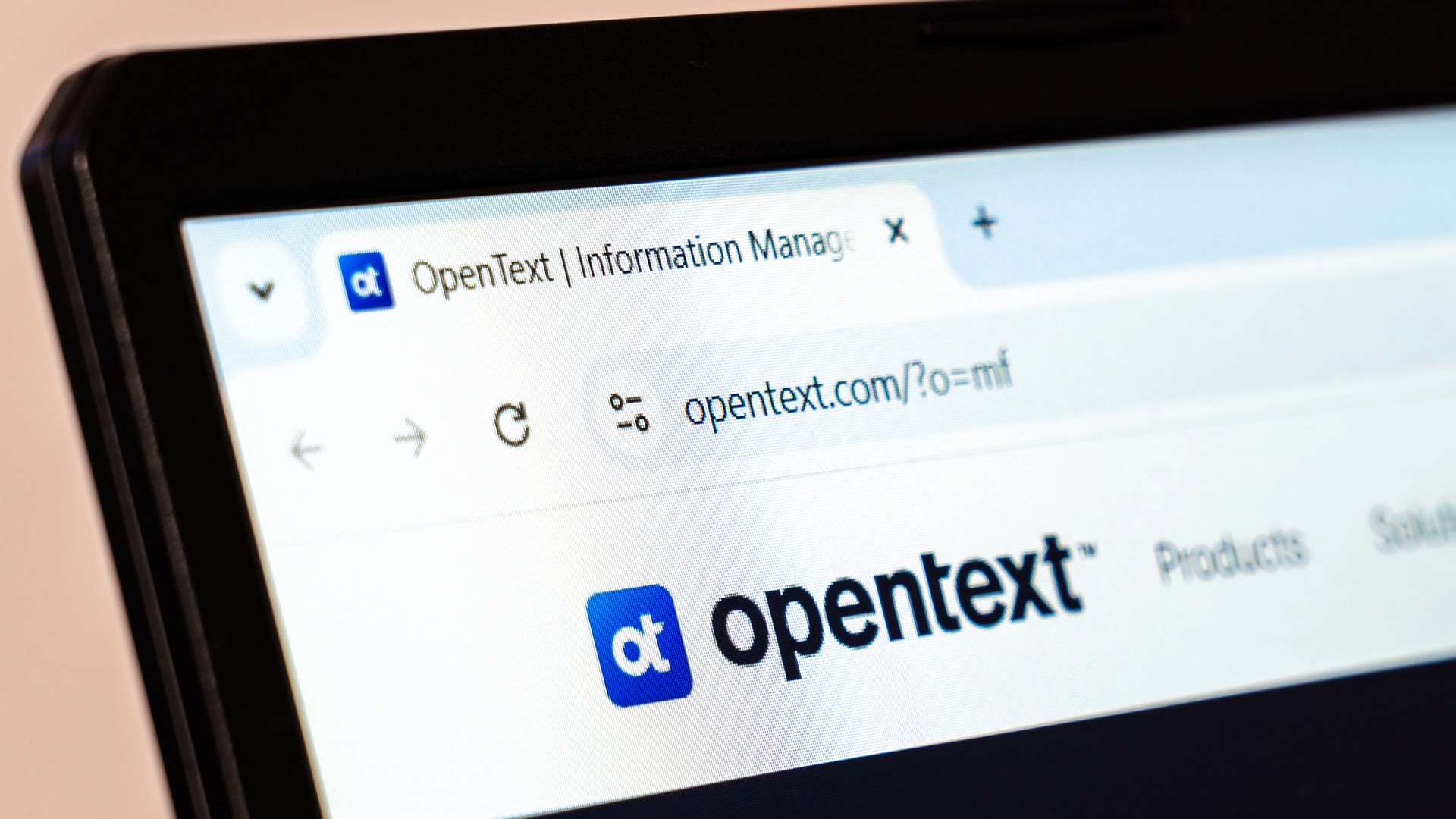Analyst(s): Keith Kirkpatrick
Publication Date: February 10, 2025
OpenText’s Q2 FY 2025 results highlight strong operational discipline with healthy margins. While cloud revenue showed steady growth, overall revenue faced headwinds due to recent divestitures and softness in key segments. The company remains focused on driving long-term expansion, supported by the upcoming launch of Titanium X and increased investment in AI-driven enterprise solutions.
What is Covered in this Article:
- OpenText’s Q2 FY 2025 financial performance
- Cloud momentum and Titanium X launch
- Security expansion and new XDR integration
- Challenges in ITOM and ADM segments
- Revised full-year revenue guidance and growth outlook
The News: OpenText (NASDAQ: OTEX) reported Q2 FY 2025 revenue of $1.3 billion (+1.3% above consensus estimates), reflecting a decline of 5% year-on-year (YoY) on an organic basis, excluding the impact of divestitures. Cloud revenue grew by 3% YoY to $462 million (+0.7% above consensus estimates), and enterprise cloud bookings came in at $250 million (+6% YoY). Non-GAAP EBITDA fell by 11% YoY and stood at $501 million (+10.1% above consensus estimates), translating to a margin of 37.6% (Q2 FY 2024: 36.9%). Non-GAAP earnings per share (EPS) came at $1.11 (+20.3% above consensus estimates), down 10% YoY due to the impact of divestitures.
“Post AMC divestiture, our number one priority was margin, and with our H1 FY 2025 and strong Q2 FY 2025 operating results, we’ve delivered,” said Mark Barrenechea, CEO & CTO of OpenText. “Now we’re ready to make growth our new number one priority.”
OpenText Q2 FY 2025: Solid Margins, Record Cloud Bookings, & Growth Uncertainty
Analyst Take: OpenText’s Q2 FY 2025 results reflect a company undergoing a strategic transition, moving beyond its margin-driven execution to refocus on growth initiatives. While the company delivered strong profitability, record cloud bookings, and disciplined cost management, revenue headwinds in key segments led to a $130 million downward revision in full-year guidance, now projected at $5.17–$5.27 billion. Despite these challenges, OpenText is positioning itself for long-term expansion, with the launch of Titanium X, enhanced AI-driven solutions, and a reinvigorated security business emerging as the key growth levers.
Cloud Momentum but Modest Growth Execution
OpenText’s cloud business continues to be a bright spot, with enterprise cloud bookings hitting a record $250 million in Q2, reflecting 6% YoY growth. This momentum has pushed total cloud remaining performance obligations (RPO) to $2.3 billion, surpassing maintenance RPO of $1.8 billion. Currently, 60% of cloud revenue is secured through existing RPO, while the remaining 40% is driven by in-year renewals and new business.
To accelerate cloud adoption, OpenText is set to launch Titanium X in Q3 FY 2025, a full-stack AI-powered cloud platform that integrates 15 AI-driven Aviators and 100+ digital agents across content, security, and business workflows. The company aims to transition its vast base of 120,000 enterprise customers to this next-generation cloud environment, offering seamless upgrades, enhanced automation, and AI-powered analytics. Additionally, OpenText OpenPath, a new perpetual licensing model, provides cloud credits to incentivize migration, which could drive long-term revenue acceleration.
Security Business Poised for Expansion
Security is emerging as a major growth focus for OpenText. The company restructured its leadership, appointing Muhi Majzoub to oversee security as a standalone business, signaling its commitment to expansion in this segment. A key initiative is the upcoming launch of an XDR (Extended Detection & Response) solution designed to integrate with Microsoft Security Copilot and hosted on Azure. This AI-powered security cloud will deliver real-time threat detection, response automation, and forensic analysis, strengthening OpenText’s footprint in enterprise security. The company is embedding XDR capabilities directly into its content management and business network platforms, ensuring a seamless security experience for its installed enterprise base.
Notable security SaaS wins in Q2 include contracts with Nestlé for code-level security using Fortify, Frost Bank for transaction encryption via Voltage, and Capgemini for identity management solutions. However, competition in cybersecurity remains intense, with established players dominating the market. Success will depend on leveraging OpenText’s existing customer base and effectively cross-selling security solutions alongside Titanium X.
ADM and ITOM Weakness Impacting Growth Outlook
Weakness in IT Operations Management (ITOM) and Application Development Management (ADM) accounted for $65–$70 million of OpenText’s $130 million guidance reduction, largely due to declines in license and maintenance revenue.
To revitalize ITOM, OpenText is relaunching its Observability and Service Management Clouds under Titanium X, with a renewed focus on IT service management and an expansion into corporate service management.
In ADM, the shift from individual developers to enterprise-scale deployments is gaining momentum, as seen in recent SaaS wins at Pfizer and Eli Lilly. Additionally, OpenText has internally deployed ADM solutions across 10,000 engineers, embedding them into Titanium X. While management remains optimistic about a turnaround, execution risks persist as OpenText works to regain momentum in these segments.
Capital Returns and Financial Discipline Provide Stability
Despite revenue challenges, OpenText remains committed to returning capital to shareholders. In Q2, the company repurchased 2.2 million shares at an average price of $29.82 and is targeting $570 million in total capital returns for FY 2025 through dividends and buybacks. Strong free cash flow generation of $307 million in Q2 and disciplined cost management provide financial flexibility as the company navigates its transition to a growth-focused model.
Path to Growth in Q4 FY 2025, but Execution Risks Remain
OpenText expects to return to organic revenue growth by Q4 FY 2025, with Titanium X, AI-driven solutions, and security expansion serving as the primary growth catalysts. However, execution risks remain, particularly in accelerating cloud revenue conversion, revitalizing ITOM and ADM, and addressing regional growth challenges, especially in Europe.
OpenText is also likely to face increasing competition from other large Saas vendors that have already deployed agentic solutions, which include both out-of-the-box AI agents and platforms that enable the creation of AI agents based on industry, task, or workflow-based templates. OpenText will need to show potential customers how their solutions are differentiated from the competition, and how they will help to generate business value.
While OpenText has laid the groundwork for long-term expansion, investors will be closely monitoring whether these initiatives can translate into sustained financial performance.
Read the full press release on the OpenText website.
Disclosure: The Futurum Group is a research and advisory firm that engages or has engaged in research, analysis, and advisory services with many technology companies, including those mentioned in this article. The author does not hold any equity positions with any company mentioned in this article.
Analysis and opinions expressed herein are specific to the analyst individually and data and other information that might have been provided for validation, not those of The Futurum Group as a whole.
Other insights from The Futurum Group:
OpenText’s Q1 FY 2025 Earnings Highlight Growth in Cloud and AI Solutions
OpenText Axcelerate Integrates AI-Power via Aviator
The Rise of AI and Enterprise Solutions – A Recap from The Six Five Webcast
Author Information
Keith Kirkpatrick is Research Director, Enterprise Software & Digital Workflows for The Futurum Group. Keith has over 25 years of experience in research, marketing, and consulting-based fields.
He has authored in-depth reports and market forecast studies covering artificial intelligence, biometrics, data analytics, robotics, high performance computing, and quantum computing, with a specific focus on the use of these technologies within large enterprise organizations and SMBs. He has also established strong working relationships with the international technology vendor community and is a frequent speaker at industry conferences and events.
In his career as a financial and technology journalist he has written for national and trade publications, including BusinessWeek, CNBC.com, Investment Dealers’ Digest, The Red Herring, The Communications of the ACM, and Mobile Computing & Communications, among others.
He is a member of the Association of Independent Information Professionals (AIIP).
Keith holds dual Bachelor of Arts degrees in Magazine Journalism and Sociology from Syracuse University.





